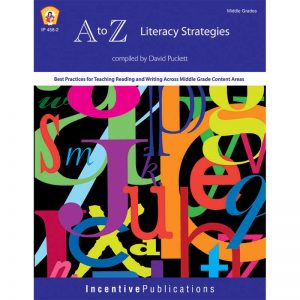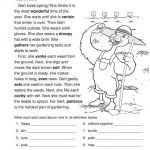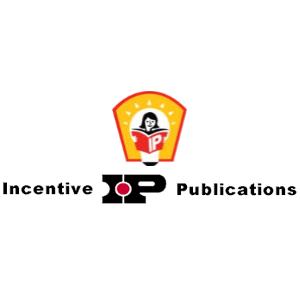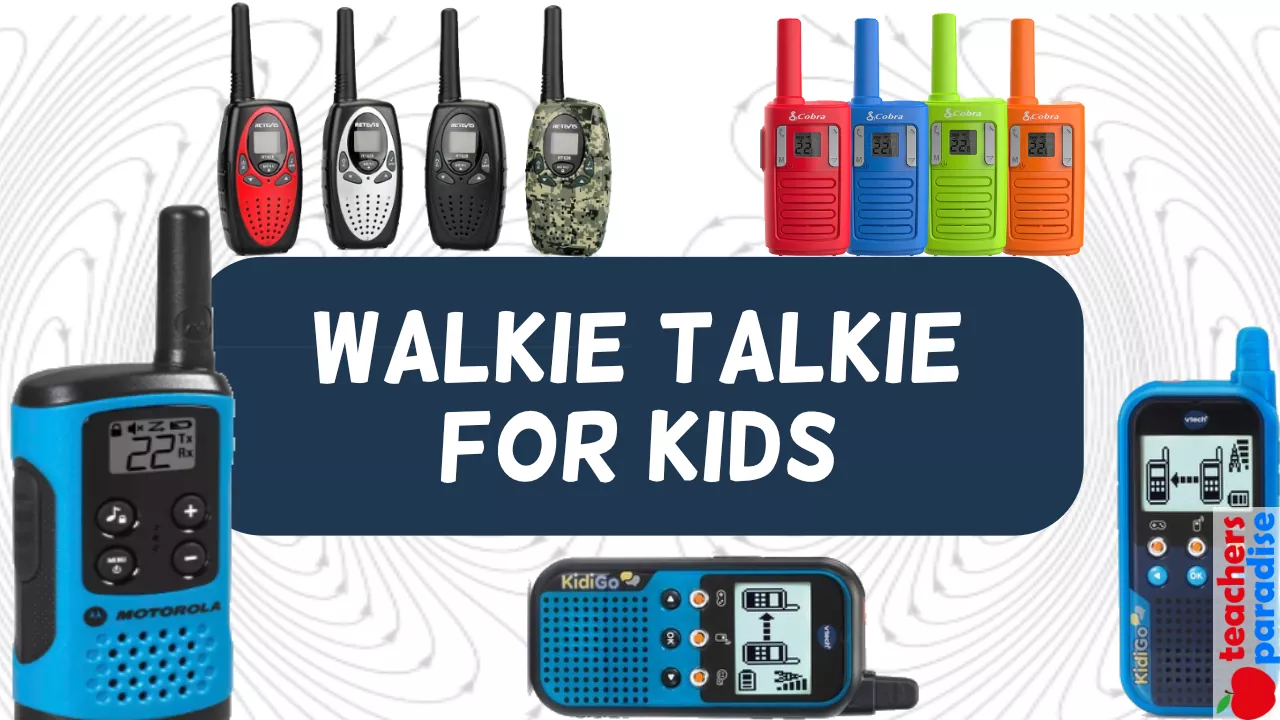SKILLS THAT MAKE A MATH WHIZ
Whole Numbers & Counting
• Recognize that numerals name numbers
• Associate word names with their corresponding numerals
• Identify equivalent and non-equivalent sets
• Arrange sets in order of size
• Count to 100 and higher (forwards & backwards)
• Count the union of two or more sets
• Skip-count by twos, fives, tens, and other intervals (forwards & backwards)
• Read and write numerals of 1-digit through 6-digits
• Read and write large numbers: millions, billions, and trillions
• Associate numerals with intervals along a number line
• Classify objects into sets
• Associate numerals with sets; write numerals to match sets
• Identify place value for 1-6 digit numerals
• Identify place value for numbers of 1,000,000 or greater
• Express numerals of 1-7 places in expanded notation
• Rename tens as ones, hundreds as tens, and thousands as hundreds
• Rename places of greater value than thousands
• Use whole number concepts in problem-solving situations
• Identify positive and negative integers
• Read and write Roman numerals
• Experiment with a non-decimal based numeration system
• Read exponential numbers
WORKSHEET & Sample PDF Activity
Sample PDF Activity
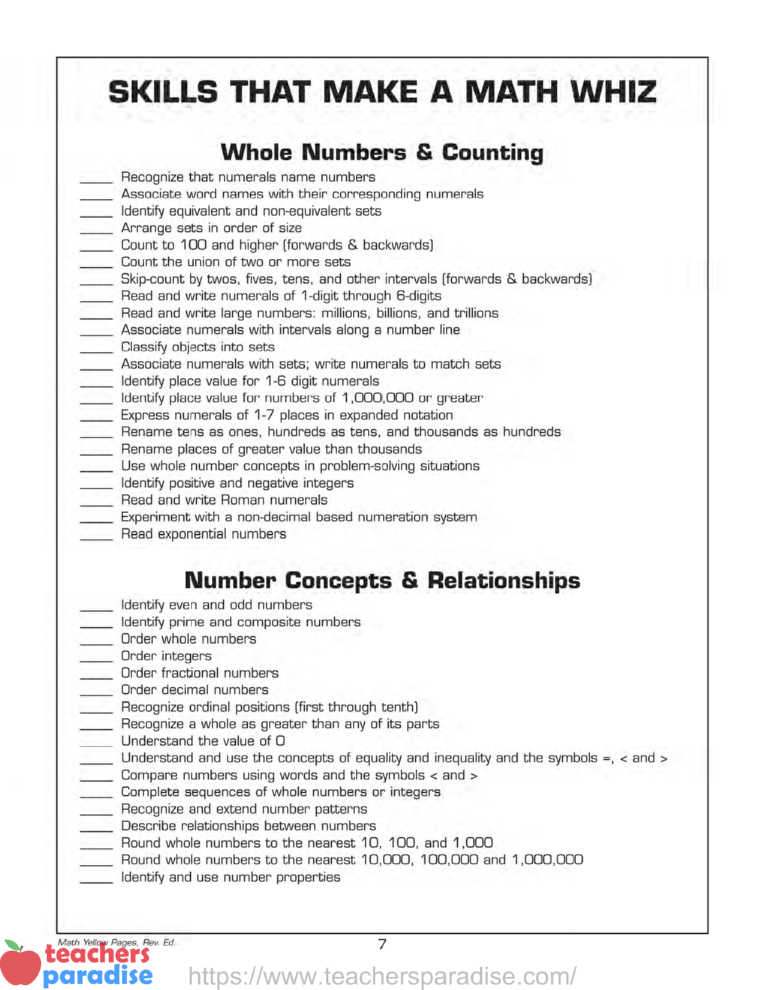
Number Concepts & Relationships
• Identify even and odd numbers
• Identify prime and composite numbers
• Order whole numbers
• Order integers
• Order fractional numbers
• Order decimal numbers
• Recognize ordinal positions (first through tenth)
• Recognize a whole as greater than any of its parts
• Understand the value of 0
• Understand and use the concepts of equality and inequality and the symbols =, < and >
• Compare numbers using words and the symbols < and >
• Complete sequences of whole numbers or integers
• Recognize and extend number patterns
• Describe relationships between numbers
• Round whole numbers to the nearest 10, 100, and 1,000
• Round whole numbers to the nearest 10,000, 100,000 and 1,000,000
• Identify and use number properties
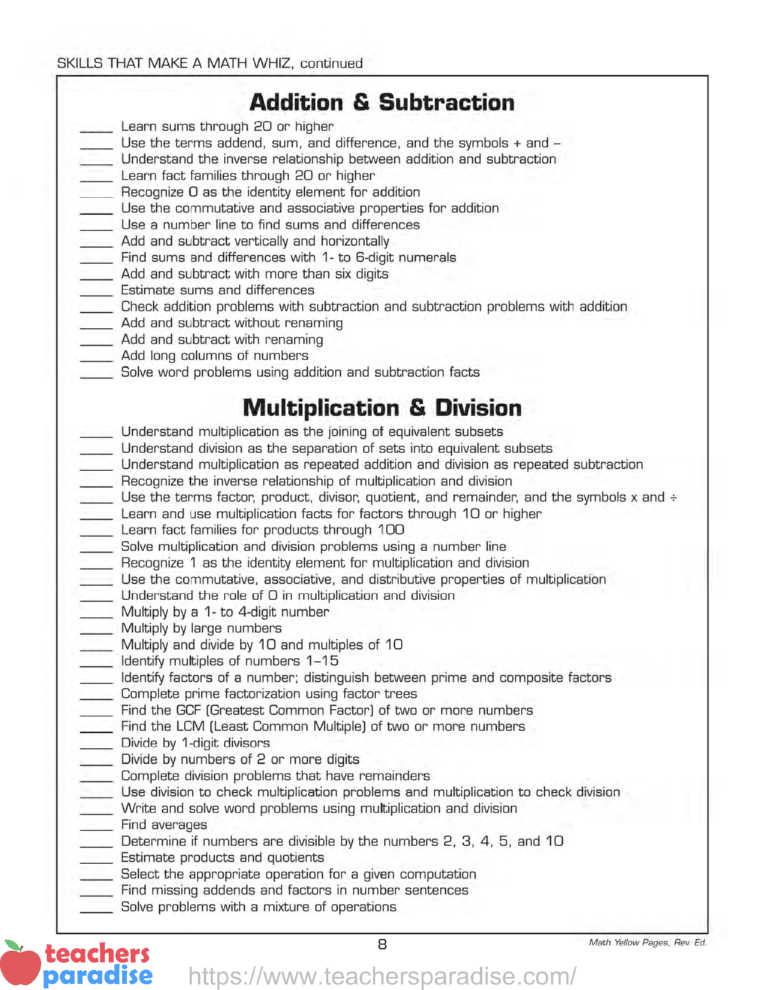
Addition & Subtraction
• Learn sums through 20 or higher
• Use the terms addend, sum, and difference, and the symbols + and –
• Understand the inverse relationship between addition and subtraction
• Learn fact families through 20 or higher
• Recognize 0 as the identity element for addition
• Use the commutative and associative properties for addition
• Use a number line to find sums and differences
• Add and subtract vertically and horizontally
• Find sums and differences with 1- to 6-digit numerals
• Add and subtract with more than six digits
• Estimate sums and differences
• Check addition problems with subtraction and subtraction problems with addition
• Add and subtract without renaming
• Add and subtract with renaming
• Add long columns of numbers
• Solve word problems using addition and subtraction facts
Multiplication & Division
• Understand multiplication as the joining of equivalent subsets
• Understand division as the separation of sets into equivalent subsets
• Understand multiplication as repeated addition and division as repeated subtraction
• Recognize the inverse relationship of multiplication and division
• Use the terms factor, product, divisor, quotient, and remainder, and the symbols x and ÷
• Learn and use multiplication facts for factors through 10 or higher
• Learn fact families for products through 100
• Solve multiplication and division problems using a number line
• Recognize 1 as the identity element for multiplication and division
• Use the commutative, associative, and distributive properties of multiplication
• Understand the role of 0 in multiplication and division
• Multiply by a 1- to 4-digit number
• Multiply by large numbers
• Multiply and divide by 10 and multiples of 10
• Identify multiples of numbers 1–15
• Identify factors of a number; distinguish between prime and composite factors
• Complete prime factorization using factor trees
• Find the GCF (Greatest Common Factor) of two or more numbers
• Find the LCM (Least Common Multiple) of two or more numbers
• Divide by 1-digit divisors
• Divide by numbers of 2 or more digits
• Complete division problems that have remainders
• Use division to check multiplication problems and multiplication to check division
• Write and solve word problems using multiplication and division
• Find averages
• Determine if numbers are divisible by the numbers 2, 3, 4, 5, and 10
• Estimate products and quotients
• Select the appropriate operation for a given computation
• Find missing addends and factors in number sentences
• Solve problems with a mixture of operations
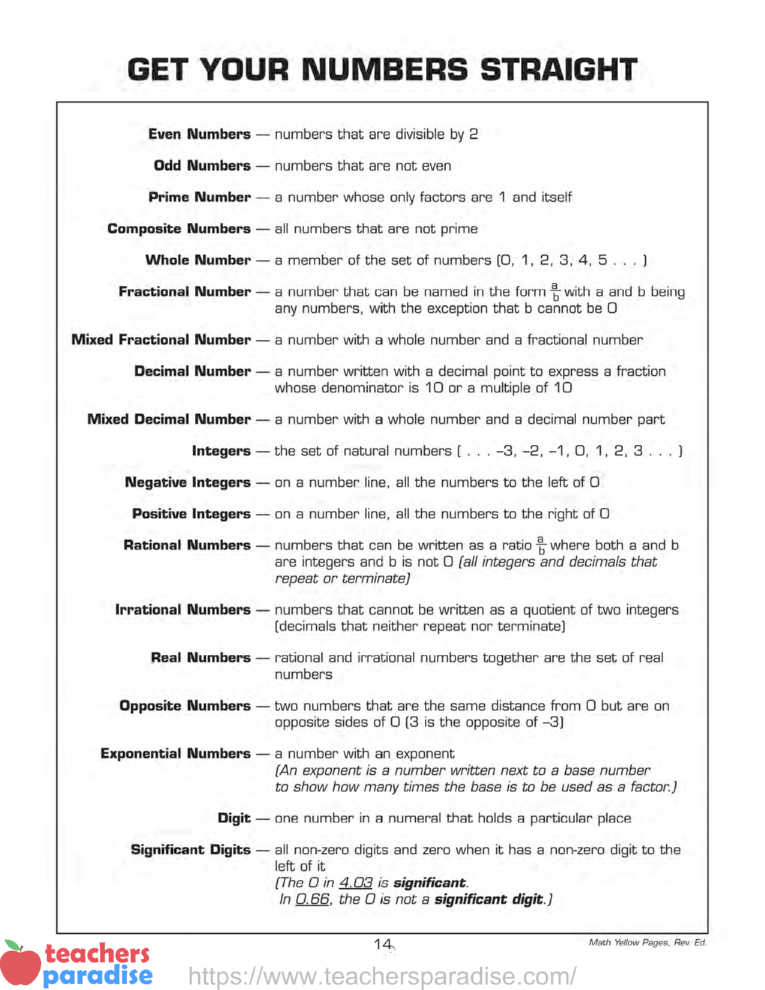
GET YOUR NUMBERS STRAIGHT
Even Numbers — numbers that are divisible by 2
Odd Numbers — numbers that are not even
Prime Number — a number whose only factors are 1 and itself
Composite Numbers — all numbers that are not prime
Whole Number — a member of the set of numbers (0, 1, 2, 3, 4, 5 . . . )
Fractional Number — a number that can be named in the form a—b with a and b being any numbers, with the exception that b cannot be 0
Mixed Fractional Number — a number with a whole number and a fractional number
Decimal Number — a number written with a decimal point to express a fraction whose denominator is 10 or a multiple of 10
Mixed Decimal Number — a number with a whole number and a decimal number part
Integers — the set of natural numbers ( . . . –3, –2, –1, 0, 1, 2, 3 . . . )
Negative Integers — on a number line, all the numbers to the left of 0
Positive Integers — on a number line, all the numbers to the right of 0
Rational Numbers — numbers that can be written as a ratio a—b where both a and bare integers and b is not 0 (all integers and decimals that repeat or terminate)
Irrational Numbers — numbers that cannot be written as a quotient of two integers(decimals that neither repeat nor terminate)
Real Numbers — rational and irrational numbers together are the set of real numbers
Opposite Numbers — two numbers that are the same distance from 0 but are on opposite sides of 0 (3 is the opposite of –3)
Exponential Numbers — a number with an exponent (An exponent is a number written next to a base number to show how many times the base is to be used as a factor.)
Digit — one number in a numeral that holds a particular place
Significant Digits — all non-zero digits and zero when it has a non-zero digit to the left of it (The 0 in 4.03is significant. In 0.66, the 0 is not a significant digit.)
Math Yellow Pages For Students And Teachers by INCENTIVE PUBLICATIONS IP890 Table of Contents
Skills That Make a Math Whiz (a checklist of math skills covering grades K–8) – 7
Whole Numbers & Counting – 7
Number Concepts & Relationships – 7
Addition & Subtraction – 8
Multiplication & Division – 8
Fractions – 9
Decimals – 9
Ratio, Proportion, & Percent – 10
Problem Solving – 10
Measurement – 11
Coordinate Graphing – 11
Statistics – 11
Geometry – 12
Probability – 12
Pre-Algebra – 13
Get Your Numbers Straight (definitions of various kinds of numbers) – 14
Important Properties (properties of numbers & operations) – 15
Mathematical Symbols (math symbols and meanings) – 16
Can You Speak Metric? (metric prefixes & meanings) – 16
All Kinds of Formulas (geometric formulas) – 17
Math Tools, Treasures, & Tidbits (things to collect for math activities) – 18
Special Math How-To’s (brief explanations of many math processes) – 19
A Handy Guide for Problem Solvers (18 different strategies for attacking & solving problems) – 26
Which Measure? (tables of English & metric measurements) – 29
Converting Measurements (tables of measurement conversions, English to metric & metric to English) – 31
Tricks for Mathematicians (fun tricks with numbers & operations) – 32
Computer Talk (terms to help you find your way around computers) – 35
Web Talk (terms to help you find your way around the Internet) – 37
Math Terms for Every Occasion (an exhaustive glossary of math terms used in grades K–8) – 39
Math Terms: Number Concepts & Relationships – 39
Math Terms: Operations & Computations – 43
Math Terms: Fractions & Decimals – 46
Math Terms: Geometry & Measurement – 48
Math Terms: Statistics, Graphing, & Probability – 58
Math Terms: Pre-Algebra – 60
Fast Facts (ready-to-copy matrices for learning math facts) – 62


